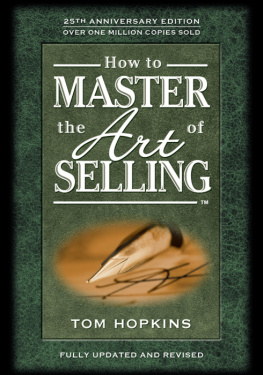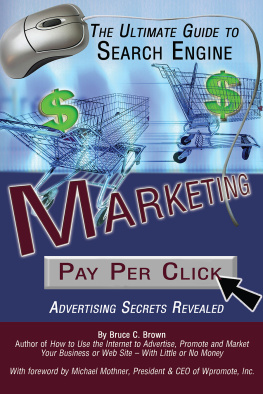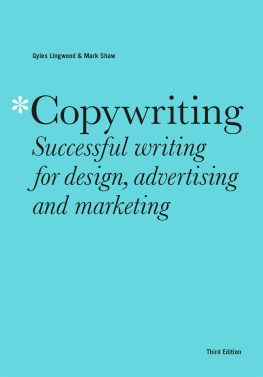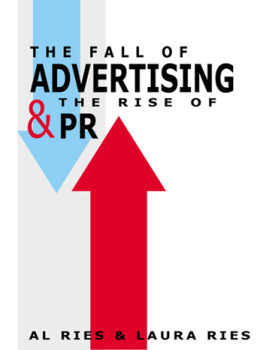Hopkins - Scientific Advertising
Here you can read online Hopkins - Scientific Advertising full text of the book (entire story) in english for free. Download pdf and epub, get meaning, cover and reviews about this ebook. year: 2012, publisher: Duke Classics, genre: Art. Description of the work, (preface) as well as reviews are available. Best literature library LitArk.com created for fans of good reading and offers a wide selection of genres:
Romance novel
Science fiction
Adventure
Detective
Science
History
Home and family
Prose
Art
Politics
Computer
Non-fiction
Religion
Business
Children
Humor
Choose a favorite category and find really read worthwhile books. Enjoy immersion in the world of imagination, feel the emotions of the characters or learn something new for yourself, make an fascinating discovery.
Scientific Advertising: summary, description and annotation
We offer to read an annotation, description, summary or preface (depends on what the author of the book "Scientific Advertising" wrote himself). If you haven't found the necessary information about the book — write in the comments, we will try to find it.
Many regard a successful marketing campaign as a mystical, hard-to-define feat that only happens when the stars align and other intangible factors happen to fall into place. Author Claude Hopkins takes the opposing view, arguing that successful advertising can be boiled down to a handful of empirical variables and scientific principles. This classic of the marketing genre is a must-read for aspiring businesspeople and entrepreneurs.
Scientific Advertising — read online for free the complete book (whole text) full work
Below is the text of the book, divided by pages. System saving the place of the last page read, allows you to conveniently read the book "Scientific Advertising" online for free, without having to search again every time where you left off. Put a bookmark, and you can go to the page where you finished reading at any time.
Font size:
Interval:
Bookmark:

From a 1923 edition
ISBN 978-1-62011-543-5
Duke Classics
2012 Duke Classics and its licensors. All rights reserved.
While every effort has been used to ensure the accuracy and reliability of the information contained in this edition, Duke Classics does not assume liability or responsibility for any errors or omissions in this book. Duke Classics does not accept responsibility for loss suffered as a result of reliance upon the accuracy or currency of information contained in this book.
The time has come when advertising has in some hands reached the status of a science. It is based onfixed principles and is reasonably exact. The causes and effects have been analyzed until they arewell understood. The correct methods of procedure have been proved and established. We know whatis most effective, and we act on basic law.
Advertising, once a gamble, has thus become, under able direction, one of the safest businessventures. Certainly no other enterprise with comparable possibilities need involve so little risk.
Therefore, this book deals, not with theories and opinions, but with well-proven principles and facts.It is written as a text book for students and a safe guide for advertisers. Every statement has beenweighed. The book is confined to establish fundamentals. If we enter any realms of uncertainty we shallcarefully denote them.
The present status of advertising is due to many reasons. Much national advertising has long beenhandled by large organizations known as advertising agencies. Some of these agencies, in their hundredsof campaigns, have tested and compared thousands of plans and ideas. The results have been watchedand recorded, so no lessons have been lost. Such agencies employ a high grade of talent. None but ableand experienced men can meet the requirements in national advertising. Working in co-operation,learning from each other and from each new undertaking, some of these men develop into masters.
Individuals may come and go, but they leave their records and ideas behind them. These becomea part of the organization's equipment, and a guide to all who follow. Thus, in the course of decades,such agencies become storehouses of advertising experiences, proved principles, and methods.
The larger agencies also come into intimate contact with experts in every department of business.Their clients are usually dominating concerns. So they see the results of countless methods and policies.They become a clearing house for every thing pertaining to merchandising. Nearly every sellingquestion which arises in business is accurately answered by many experiences.
Under these conditions, where they long exist, advertising and merchandising become exactsciences. Every course is charted. The compass of accurate knowledge directs the shortest, safest,cheapest course to any destination. We learn the principles and prove them by repeated tests. This isdone through keyed advertising, by traced returns, largely by the use of coupons. We compare one waywith many others, backward and forward, and record the results. When one method invariably provesbest, that method becomes a fixed principle.
Mail order advertising is traced down to the fraction of a penny. The cost per reply and cost perdollar of sale show up with utter exactness. One ad in compared with another, one method with another.Headlines, settings, sizes, arguments and pictures are compared. To reduce the cost of results even onepercent means much in some mail order advertising. So no guesswork is permitted. One must knowwhat is best. Thus mail order advertising first established many of our basic laws.
In lines where direct returns are impossible, we compare one town with another. Scores of methodsmay be compared in this way, measured by cost of sales.
But the most common way is by use of the coupon. We offer a sample, a book, a free package, orsomething to induce direct replies. Thus we learn the amount of action which each ad engenders.
But those figures are not final. One ad may bring too many worthless replies, another replies that arevaluable. So our final conclusions are always based on cost per customer or cost per dollar of sale.
These coupon plans are dealt with further in the chapter on "Test Campaigns." Here we explain onlyhow we employ them to discover advertising principles.
In a large agency coupon returns are watched and recorded on hundreds of different lines. In a singleline they are sometimes recorded on thousands of separate ads. Thus we test everything pertaining toadvertising. We answer nearly every possible question by multitudinous traced returns.
Some things we learn in this way apply only to particular lines. But even those supply basicprinciples for analogous undertakings.
Others apply to all lines. They become fundamentals for advertising in general. They are universallyapplied. No wise advertiser will ever depart from those unvarying laws.
We propose in this book to deal with those fundamentals, those universal principles. To teach onlyestablished techniques. There is that technique in advertising, as in all art, science and mechanics. Andit is, as in all lines, a basic essential.
The lack of those fundamentals has been the main trouble with advertising of the past. Each workerwas a law to himself. All previous knowledge, all progress in the line, was a closed book to him.
It was like a man trying to build a modern locomotive without first ascertaining what others haddone. It was like a Columbus starting out to find an undiscovered land. Men were guided by whims andfancies - vagrant, changing breezes. They rarely arrived at their port. When they did - by accident - itwas by a long roundabout course. Each early mariner in this sea mapped his own separate course. Therewere no charts to guide him. Not a lighthouse marked a harbor, not a bouy showed a reef. The wreckswere unrecorded, so countless ventures came to grief on the same rocks and shoals.
Advertising was then a gamble -a speculation of the rashest sort. One man's guess on the propercourse was as likely to be as good as another's. There were no safe pilots, because few sailed the samecourse twice.
The condition has been corrected. Now the only uncertainties pertain to people and to products, notto methods. It is hard to measure human idiosyncrasies, the preferences and prejudices, the likes anddislikes that exist. We cannot say that an article will be popular, but we know how to sell it in the mosteffective way. Ventures may fail, but the failures are not disasters. Losses, when they occur, are buttrifling. And the causes are factors which has nothing to do with the advertising.
Advertising has flourished under these new conditions. It has multiplied in volume, in prestige andrespect. The perils have increased many fold. Just because the gamble has become a science, thespeculation a very conservative business.
These facts should be recognized by all. This is no proper field for sophistry or theory, or for anyother will-o'-the-wisp. The blind leading the blind is ridiculous. It is pitiful in a field with such vastpossibilities. Success is a rarity, a maximum success an impossibility, unless one is guided by laws asimmutable as the law of gravitation.
So our main purpose here is to set down those laws, and to tell you how to prove them for yourself.After them come a myriad variations. No two advertising campaigns are ever conducted on lines that areidentical. Individuality is an essential. Imitation is a reproach. But those variable things which dependon ingenuity have not place in a text book on advertising. This is for groundwork only.
Font size:
Interval:
Bookmark:
Similar books «Scientific Advertising»
Look at similar books to Scientific Advertising. We have selected literature similar in name and meaning in the hope of providing readers with more options to find new, interesting, not yet read works.
Discussion, reviews of the book Scientific Advertising and just readers' own opinions. Leave your comments, write what you think about the work, its meaning or the main characters. Specify what exactly you liked and what you didn't like, and why you think so.


















